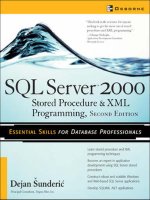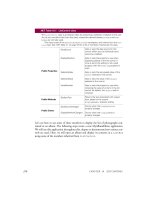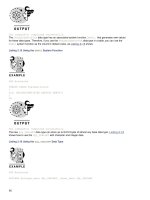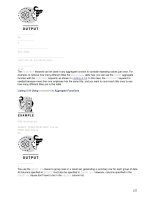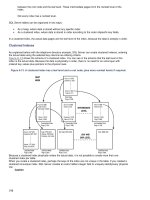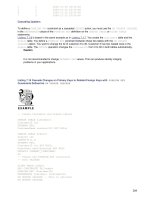SQL Server 2000 Stored Procedure Programming phần 8 pps
Bạn đang xem bản rút gọn của tài liệu. Xem và tải ngay bản đầy đủ của tài liệu tại đây (698.12 KB, 76 trang )
514
SQL Server 2000 Stored Procedure Programming
The Database Access tab controls the databases the user can
access and the user’s membership in roles:
You can also grant logins using stored procedures. You can use
sp_grantlogin to create a login on SQL Server. To give a Windows
user access to a SQL Server, only the name of the user is required
as a parameter:
exec sp_grantlogin 'Accounting\TomB'
However, when you create a login for SQL Server, you usually
specify an authentication password and a default database as well:
exec sp_grantlogin 'TomB', 'password', 'Asset'
Granting Database Access
As we have shown, database access can be granted to a login during
the login’s creation. There is also a way to grant access to additional
databases after the login has been created. Database users can be
managed from the Users node of a database in Enterprise Manager.
You can both manage existing users and create new users.
Login names have to be selected from the list box. The User Name
is set by default to the name of the login. This default is not required,
but it simplifies user management. In the Database Role Membership
section, you check all databases to which you want to grant the user
membership:
You can perform the same operation from Transact-SQL. To grant
access to the database, use sp_grantdbaccess:
exec sp_grantdbaccess 'TomB', 'TomB'
You can review access using sp_helpusers and revoked using
sp_revokedbaccess.
To assign a user to a user-defined database role, you issue a
command such as
exec sp_addrolemember 'TomB', 'Management'
Chapter 11: Interaction with the SQL Server Environment
515
You can review membership using sp_helprolemember and
revoke it using sp_droprolemember. You can create roles using
sp_addrole:
exec sp_addrole 'Management'
You can remove roles using sp_droprole. To view a list of roles,
use sp_helpfixeddbroles and sp_helproles.
Assigning Permissions
The system of permissions controls user and role access to database
objects and statements. Permissions can exist in one of following
three states:
▼
Granted
■
Denied
▲ Revoked
Granted means that a user has permission to use an object or
statement. Denied means that a user is not allowed to use a statement
or object, even if the user has previously inherited permission (that
is, he is member of a role that has permission granted). Physically, a
record is stored in the sysprotects table for each user (or role) and
object (or statement) for which permission has been granted or denied.
When a permission is Revoked, records that were stored for that
security account (that is, the records granting or revoking permissions)
are removed from the sysprotects table.
Because of their physical implementation, permissions are
cumulative. For example, a user can receive some permissions from
one role and missing permissions from some other role. Or, the
user can lose some permissions that have been granted to all other
members of a role.
You can control statement permissions from the Permissions tab
of a database’s Properties dialog. You can set object permissions
using the Permissions button in a database object’s Properties dialog.
In both cases, you see a list of users and roles:
516
SQL Server 2000 Stored Procedure Programming
Chapter 11: Interaction with the SQL Server Environment
517
An administrator can grant (þ), deny ( ), or revoke (ý)
permissions.
Grant Statement
To grant statement permission, an administrator can
issue a Grant statement with the following syntax:
Grant {ALL |
statement_name_1
[,
statement_name_2
, …
statement_name_n
]
}
To
account_1
[,
account_2
, …
account_n
]
To grant object permission, an administrator can issue a Grant
statement with the following syntax:
Grant {All [Privileges]|
permission_1
[,
permission_2
, …
permission_n
]}
{
[
column_1
,
column_2
, …
column_n
] ON {table | view }
| On {table | view } [
column_1
,
column_2
, …
column_n
]
| On {
stored_procedure
}
}
To
account_1
[,
account_2
, …
account_n
]
[With Grant Option]
As {group | role}
518
SQL Server 2000 Stored Procedure Programming
The following statement allows JohnS (SQL Server login) and
TomB from the Accounting domain (Windows domain user) to create
a table in the current database:
Grant Create Table
To JohnS, [Accounting\TomB]
The following statement allows members of the AssetOwners role
to view, store, delete, and change records in the Inventory table:
Grant Select, Insert, Update, Delete
On Inventory
To AssetOwners
Deny Statement
The Deny statement is used to negate permissions.
Its syntax is basically the same as the syntax of the Grant statement
(except that the keyword Deny is used).
The following statement prevents TomB from the Accounting
domain from creating a database:
Deny Create Database
To [Accounting\TomB]
The following statement prevents JohnS from deleting and
changing records from the Inventory table, even though he has
inherited rights to view, store, delete, and change records as a
member of the AssetOwners role:
Deny Update, Delete
On Inventory
To JohnS
Revoke Statement
The Revoke statement is used to deactivate
statements that have granted or denied permissions. It has the same
syntax as the Grant and Deny statements (except that the keyword
Revoke is used).
It is easy to understand that permission can be removed using
this statement. It is a little more challenging to understand how a
permission can be granted by revoking it. Let’s review an example in
which a user JohnS is a member of the AssetOwners role, which has
permission to insert, update, select, and delete records from the
Inventory table.
exec sp_addrolemember 'JohnS', 'AssetOwners'
The Administrator then decides to deny JohnS permission to delete
and update records from Inventory:
Deny Update, Delete
On Inventory
To JohnS
After a while the administrator issues the following statement:
Revoke Update, Delete
On Inventory
To JohnS
In effect, this command has granted Update and Delete permission
on the Inventory table to JohnS.
Since the Revoke statement removes records from the sysprotects
table in the current database, the effect of the Revoke statement is to
return permissions to their original state. Naturally, this means that
the user will not have access to the object (or statement). In that respect,
its effect is similar to the Deny statement. However, there is a major
difference between revoked and denied permissions: the Revoke
statement does not prevent permissions from being granted in the future.
Synchronization of Login and User Names
In the section earlier in this chapter called “Database Deployment,”
I mentioned the common problem of mismatches between users and
logins when databases are copied from one server to another. The
problem is a product of the fact that records in the sysusers table of
the copied database point to the records in the syslogins table with
matching loginid field. One solution is to create and manage a script
that recreates logins and users on the new server after a database
is copied.
Chapter 11: Interaction with the SQL Server Environment
519
SQL Server also offers the sp_change_users_login procedure. You
can use it to display mapping between user and login:
exec sp_change_users_login @Action = 'Report',
@UserNamePattern = 'B%'
You can set a login manually for a single user:
exec sp_change_users_login @Action = 'Update_one',
@UserNamePattern = 'TomB',
@LoginName = 'TomB'
SQL Server can also match database users to logins with the
same name:
exec sp_change_users_login @Action = 'Auto_Fix',
@UserNamePattern = '%'
For each user, SQL Server tries to find a login with the same name
and to set the login ID.
TIP:
sp_change_users_login with
‘Auto_Fix’
does a decent job, but
the careful DBA should inspect the results of this operation.
Managing Application Security Using Stored Procedures,
User-Defined Functions, and Views
When a permission is granted on a complex object like a stored
procedure, a user-defined function, or a view, a user does not need
to have permissions on the objects or statements inside it.
We can illustrate this characteristic in the following example:
Create Database Test
Go
sp_addlogin @loginame = 'AnnS',
@passwd = 'password',
@defdb = 'test'
GO
520
SQL Server 2000 Stored Procedure Programming
Use Test
Exec sp_grantdbaccess @loginame = 'AnnS',
@name_in_db = 'AnnS'
Go
Create Table aTable(
Id int identity(1,1),
Description Varchar(20)
)
Go
Create Procedure ListATable
as
Select * from aTable
go
Create Procedure InsertATable
@Desc varchar(20)
as
Insert Into aTable (Description)
Values (@Desc)
Go
Deny Select, Insert, Update, Delete
On Atable
To Public
Grant Execute
On InsertATable
To Public
Grant Execute
On ListATable
To Public
Go
Chapter 11: Interaction with the SQL Server Environment
521
A table is created along with two stored procedures for viewing
and inserting records into it. All database users are prevented from
using the table directly but granted permission to use the stored
procedures.
NOTE:
All database users are automatically members of the Public role.
Whatever is granted or denied to the Public role is automatically granted or
denied to all database users.
After this script is executed, you can log in as AnnS in Query
Analyzer and try to access the table directly and through stored
procedures. Figure 11-4 illustrates such attempts.
522
SQL Server 2000 Stored Procedure Programming
Figure 11-4. Stored procedures are accessible even when underlying objects are not
Stored procedures, user-defined functions, and views are
important tools for implementing sophisticated security solutions
in a database. Each user should have permissions to perform
activities tied to the business functions for which he or she is
responsible and to view only related information. It is also easier to
manage security in a database on a functional level than on the data
level. Therefore, client applications should not be able to issue ad hoc
queries against tables in a database. Instead, they should execute
stored procedures.
Users should be grouped in roles by the functionality they
require, and roles should be granted execute permissions to related
stored procedures. Since roles are stored only in the current database,
using them helps you avoid problems that occur during the transfer
of the database from the development to the production environment
(see “Database Deployment” earlier in the chapter).
NOTE:
There is one exception to the rule we have just described. If the
owner of the stored procedure is not the owner of the database objects by
the stored procedure, SQL Server will check the object’s permissions on
each underlying database object. Usually, this is not an issue because all
objects are owned by dbo.
Managing Application Security Using a Proxy User
Security does not have to be implemented on SQL Server. If the
application is developed using three-tier architecture, objects can
use roles, users, and other security features of Microsoft Transaction
Server (on Windows NT) or Component Services (in Windows 2000)
to implement security. Security is sometimes also implemented
inside the client application.
In both cases, database access is often accomplished through a
single database login and user. Such a user is often called a proxy user.
Chapter 11: Interaction with the SQL Server Environment
523
NOTE:
The worst such solution occurs when the client application
developer completely ignores SQL Server security and achieves database
access using the
sa
login. I have seen two variants on this solution.
One occurs when the developer hard-codes the sa password inside an
application. The administrator is then prevented from changing the password
and the security of the entire SQL Server is exposed.
The other occurs when a developer stores login information in a file or
Registry so that it can be changed later. Unfortunately, it can also be read by
unauthorized persons, and again, SQL Server security is compromised.
Managing Application Security Using Application Roles
Application roles are a new feature that can be used in SQL Server 7.0
and SQL Server 2000. These are designed to implement security for
particular applications. They are different from standard database
roles in that
▼
Application roles require passwords to be activated.
■ They do not have members. Users access a database via an
application. The application contains the name of the role and
its password.
▲
SQL Server ignores all other user permissions when the
application role is activated.
To create an application role, administrators should use
sp_addapprole:
Exec sp_addapprole @rolename = 'Accounting', @password = 'password'
Permissions are managed using Grant, Deny, and Revoke
statements in the usual manner.
A client application (or a middle-tier object) should first log into
SQL Server in the usual manner and then activate the application role
using sp_setapprole:
Exec sp_setapprole @rolename = 'Accounting', @password = 'password'
524
SQL Server 2000 Stored Procedure Programming
Chapter 11: Interaction with the SQL Server Environment
525
NOTE:
Solutions based on application roles are good replacements for
solutions based on proxy users. However, my recommendation is to use
the solution described in “Managing Application Security Using Stored
Procedures, User-Defined Functions, and Views” earlier in the chapter.
SUMMARY
The primary function of SQL Server is to serve clients with answers
to their queries. However, it has become the norm in development
environments to access programs and procedures implemented in
other languages and installed in other environments.
Earlier versions of SQL Server were able to run operating system
commands and programs from the command shell and to return
output in the form of a resultset. Extended stored procedures gave
developers the opportunity to write and use code written in C to
implement things that were not possible in Transact-SQL statements.
One of the interesting new features in SQL Server is the ability to
execute methods and use the properties of COM (OLE Automation)
objects. This feature opens a whole new world to Transact-SQL code.
It is possible to run complicated numeric calculations, notify
administrators using graphics and/or sound, and initiate processes
on other machines, to name but a few applications. We have also
demonstrated in this chapter how to create such COM objects in
Visual Basic.
The standard ways that SQL Server uses to notify administrators
of events that have occurred on a SQL Server is by pager and by
e-mail. SQL Server can also receive and answer queries by e-mail.
It is possible to set and use these features from Enterprise Manager,
but in cases where more control is needed, developers can use
system stored procedures and extended stored procedures.
An important channel for communications with users and
administrators today is the Web. SQL Server can create Web pages
based on the contents of database tables or generated resultsets. SQL
Server includes a wizard to generate common Web pages, but it
also includes a set of stored procedures for creating and executing
Web tasks. The result of the wizard and system stored procedures
are pages that are far from perfect but that can be used to get and
display results quickly.
System and user-defined stored procedures can be used to perform
all administrative activities in SQL Server. Everything you can do
through Enterprise Manager can also be done using stored procedures.
It is also possible to create and execute scheduled jobs that consist
of steps written in Transact-SQL, operating system commands, or
ActiveX Script.
One of the final activities in the database development cycle is
the deployment of a database (developed in a test environment)
into a production environment. In the past, developers and
administrators had to use various tricks to accomplish this migration,
but SQL Server 2000 and SQL Server 7.0 treat database files like
any other files. It is possible to detach them, copy them, and then
attach them to another server.
Stored procedures are an important tool for managing application,
database, and SQL Server security. On the system level, you can
use system or custom stored procedures to manage logins, users,
roles, and their permissions. On the application level, security is
easiest to design and manage when functionality is implemented as
stored procedures, user-defined functions, and views, and when
groups of users are granted access to the appropriate functionality
through database roles.
EXERCISES
1. Create a trigger on the ActivityLog table that will send e-mail
to the administrator when any record that contains the word
“Critical” as the first word of a Note is inserted.
2. Create a Transact-SQL batch that will compress files in the
backup folder and transfer them to a drive on another machine.
3. Create a Transact-SQL batch that will create a scheduled job
for compressing backup files. The job should be scheduled to
run once a day.
526
SQL Server 2000 Stored Procedure Programming
CHAPTER
12
XML Support in SQL
Server 2000
527
Terms of Use
M
icrosoft SQL Server has become a giant among the select
group of enterprise-ready Relational Database Management
Systems, but as with those other RDBMSs, its roots are in
pre-Internet solutions.
The Internet revolution has highlighted a set of old tactical and
strategic challenges for the Microsoft SQL Server development team.
These challenges include
▼
Storing the large amounts of textual information that
Web-based, user-friendly database applications require
■
Delivering that textual (and other) stored information to
the Web
▲
Sharing information with other departments and
organizations that do not use the same RDBMS system
In earlier editions of SQL Server, Microsoft has addressed these
issues with such features as Full Text Search, the Web Publishing
Wizard, DTS, ADO, and OLE DB. SQL Server 2000 introduces XML
compatibility—the new holy grail of the computing industry and
the latest attempt to tackle the same old problems.
XML (R)EVOLUTION
To communicate with customers in today’s rich-content world,
you need to provide them with information. Until very recently,
such information was inevitably encapsulated in proprietary,
document-based formats that are not shared easily. For example,
word processor documents are optimized for delivery on paper,
and relational databases are often structured and normalized in
formats unsuitable to end users.
The first step in the right direction was Standard Generalized
Markup Language (SGML). Although it was designed by Charles
Goldfarb in the late 1960s, it became the international standard for
defining markup languages in 1986 after the creation of the ISO
standard. In the late 1980s, companies and government agencies
started to adopt this tag-based language. It allowed them to create
528
SQL Server 2000 Stored Procedure Programming
and manage paper documentation in a way that was easy to share
with others.
Then in the 1990s, the Web appeared on the scene and our
collective focus shifted from isolated islands of personal computers
and local networks to a global network of shared information. SGML’s
tagged structure would seem to make it a perfect candidate to lead the
Internet revolution, but the complexity of SGML makes it difficult to
work with and unsuited to Web application design.
Instead of SGML, the developers of the Internet adopted the
Hypertext Markup Language (HTML), a simple markup language used
to create hypertext documents that are portable from one platform to
another. HTML is a simplified subset of SGML. It was defined in 1991
by Tim Berners-Lee as a way to organize, view, and transfer scientific
documents across different platforms. It uses the Hypertext Transfer
Protocol (HTTP) to transfer information over the Internet. This new
markup language was an exciting development and soon found
nonscientific applications. Eventually, companies and users started
to use it as a platform for e-commerce—the processing of business
transactions without the exchange of paper-based business documents.
Unfortunately, HTML has some disadvantages. One of the biggest
is a result of its main purpose. HTML is designed to describe only how
information should appear—that is, its format. It was not designed
to define the syntax (logical structure) or semantics (meaning) of a
document. It could make a document readable to a user, but it
required that user to interact with the document and interpret it. The
computer itself could not parse the document because the necessary
“meta-information” (literally, information about the information) was
not included with the document.
Another problem with HTML is that it is not extensible. It is not
possible to create new tags. HTML is also a “standard” that exists in
multiple versions—and multiple proprietary implementations. Web
developers know that they have to test even their static HTML pages
in all of the most popular browsers (and often in several versions of
each), because each browser (and each version of each browser)
implements this “standard” somewhat differently. Different
development toolsets support different versions of this standard
(and often different features within a single standard).
Chapter 12: XML Support in SQL Server 2000
529
In 1996, a group working under the auspices of the World Wide
Web Consortium (W3C) created a new standard tagged language
called eXtensible Markup Language (XML). It was designed to address
some of the problems of HTML and SGML. XML is a standardized
document formatting language, a subset of SGML, that enables a
publisher to create a single document source that can be viewed,
displayed, or printed in a variety of ways. As is the case with HTML,
XML is primarily designed for use on the Internet. HTML, however,
is designed primarily to address document formatting issues, while
XML addresses issues relating to data and object structure. XML
provides a standard mechanism for any document builder to define
new XML tags within any XML document. Its features lower the
barriers for creation of integrated, multiplatform, application-to-
application protocols.
INTRODUCTION TO XML
In today’s world, words such as “tag,” “markup,” “element,”
“attributes,” and “schema” are buzzwords that you can hear anywhere
(well, at least in the IT industry), but what do these terms mean in the
context of markup languages?
Introduction to Markup Languages
In a broader sense, a markup is anything that you place within a
document that provides additional meaning or additional information.
For example, in this book we use italic font to emphasize each new
phrase or concept that we define or introduce. I have a habit of using a
highlighter when I am reading books. Each time I use my highlighter, I
change the format of the text as a means of helping me find important
segments later.
Markups usually define
▼
Formatting
■
Structure
▲
Meaning
530
SQL Server 2000 Stored Procedure Programming
532
SQL Server 2000 Stored Procedure Programming
XML
Let’s take a look at a simple example of an XML document:
<Inventory>
<Asset Inventoryid="5">
<Equipment>Toshiba Portege 7020CT</Equipment>
<EquipmentType>Notebook</EquipmentType>
<LocationId>2</LocationId>
<StatusId>1</StatusId>
<LeaseId>1234</LeaseId>
<LeaseScheduleId>1414</LeaseScheduleId>
<OwnerId>83749271</OwnerId>
<Cost>6295.00</Cost>
<AcquisitionType>Lease</AcquisitionType>
</Asset>
</Inventory>
Elements
An XML document must contain one or more elements. One of them is
not part of any other element and therefore it is called the document’s
root element. It must be uniquely named. In the preceding example, the
root element is named Inventory.
Each element can contain one or more other elements. In the
preceding example, the Inventory element contains one Asset
element. The Asset element also contains other elements. The
Equipment element contains just its content—the text string
“Toshiba Portege 7020CT”.
Unlike HTML, XML is case sensitive. Therefore, <Asset>,
<asset>, and <ASSET> are different tag names.
It is possible to define an empty element. Such elements can
be displayed using standard opening and closing tags:
<Inventory></Inventory>
or using special notation:
<Inventory/>
Chapter 12: XML Support in SQL Server 2000
533
If an element contains attributes but no content, an empty element is
an efficient way to write it.
<Asset Inventoryid="5"/>
An element can have more than one attribute. The following
example shows an empty element that contains nine attributes:
<Asset Inventoryid="12" EquipmentId="1" LocationId="2" StatusId="1"
LeaseId="1" LeaseScheduleId="1" OwnerId="1" Lease="100.0000"
AcquisitionTypeID="2"/>
You are not allowed to repeat an attribute in the same tag. The
following example shows a syntactically incorrect element:
<Inventory Inventoryid="12" Inventoryid="13"/>
Processing Instructions
An XML document often starts with a tag that is called a processing
instruction. For example, the following processing instruction notifies
the reader that the document it belongs to is written in XML that
complies with version 1.0.
<?xml version="1.0"?>
A processing instruction has the following format:
<?
name data
?>
The name portion identifies the processing instruction to the application
that is processing the XML document. Names must start with XML. The
data portion that follows is optional. It could be used by the application.
TIP:
It is not required but is recommended that you start an XML document
with a processing instruction that explicitly identifies that document as an
XML document defined using a specified version of the standard.
534
SQL Server 2000 Stored Procedure Programming
Document Type Definition and Document Type Declaration
We mentioned earlier that markups are meaningless if it is not
possible to define rules for
▼
What constitutes a markup
▲
What a markup means
A Document Type Definition (DTD) is a type of document that
is often used to define such rules for XML documents. The DTD
contains descriptions and constraints (naturally, not Transact-SQL
constraints) for each element (such as the order of element attributes
and membership). User agents can use the DTD file to verify that an
XML document complies with its rules.
The DTD can be an external file that is referenced by an XML
document:
<!DOCTYPE Inventory SYSTEM "Inventory.dtd">
or it can be part of the XML document itself:
<?xml version="1.0"?>
<!DOCTYPE Inventory [
<!ELEMENT Inventory (Asset+)>
<!ELEMENT Asset (EquipmentId, LocationId, StatusId, LeaseId,
LeaseScheduleId, OwnerId, Cost, AcquisitionTypeID)>
<!ATTLIST Asset Inventoryid CDATA #IMPLIED>
<!ELEMENT EquipmentId (#PCDATA)>
<!ELEMENT LocationId (#PCDATA)>
<!ELEMENT StatusId (#PCDATA)>
<!ELEMENT LeaseId (#PCDATA)>
<!ELEMENT LeaseScheduleId (#PCDATA)>
<!ELEMENT OwnerId (#PCDATA)>
<!ELEMENT Cost (#PCDATA)>
<!ELEMENT AcquisitionTypeID (#PCDATA)>
]>
<Inventory>
<Asset Inventoryid="5">
<EquipmentId>1</EquipmentId>
<LocationId>2</LocationId>
Chapter 12: XML Support in SQL Server 2000
535
<StatusId>1</StatusId>
<LeaseId>1</LeaseId>
<LeaseScheduleId>1</LeaseScheduleId>
<OwnerId>1</OwnerId>
<Cost>1295.00</Cost>
<AcquisitionTypeID>1</AcquisitionTypeID>
</Asset>
</Inventory>
The DTD document does not have to be stored locally. A
reference can include a URL or URI that provides access to the
document:
<!DOCTYPE Inventory SYSTEM " />A universal resource identifier (URI) identifies a persistent resource on
the Internet. It is a number or name that is globally unique. A special
type of URI is a universal resource locator (URL) that defines a location of
a resource on the Internet. A URI is more general because it should find
the closest copy of a resource or because it would eliminate problems in
finding a resource that was moved from one server to another.
XML Comments and CDATA sections
It is possible to write comments within an XML document. The basic
syntax of the comment is
<!
commented text
>
Commented text can be any character string that does not contain
two consecutive hyphens “ ” and that does not end with a hyphen
“-”. Comments can stretch over more than one line:
<! This is a comment. >
<!
This is another comment.
>
Comments cannot be part of any other tag:
<Order <! This is an illegal comment. > OrderId = "123">
</Order>
You can use CDATA sections in XML documents to insulate blocks
of text from XML parsers. For example, if you are writing an article
about XML and you want also to store it in the form of an XML
document, you can use CDATA sections to force XML parsers to
ignore markups with sample XML code.
The basic syntax of a CDATA section is
<![CDATA[
string
]]>
The string can be any character string that does not contain “]]>“ in
sequence. CDATA sections can occur anywhere in an XML document
where character data is allowed.
<Example>
<Text>
<![CDATA[<Inventory Inventoryid="12"/>]]>
</Text>
</Example>
Character and Entity References
Like HTML and SGML, XML also includes a simple way to reference
characters that do not belong to the ASCII character set. The syntax of
a character reference is
&#
NNNNN
;
&#x
XXXX
;
The decimal (NNNNN) or hexadecimal (XXXX) code of the character
must be preceded by “&#” or “&#x”, respectively, and followed by a
semicolon “;”.
Entity references are used in XML to insert characters that would
cause problems for the XML parser if they were inserted directly
into the document. This type of reference is basically a mnemonic
alternative to a character reference. There are five basic entity
references:
536
SQL Server 2000 Stored Procedure Programming
Entity Meaning
& &
' ‘
< <
> >
" “
Entity references are often used to represent characters with
special meaning in XML. In the following example, entity references
are used to prevent the XML parser from parsing the content of the
<Text> tag:
<Example>
<Text>
<Inventory Inventoryid="12"/>
</Text>
</Example>
Structure of XML Documents
XML Documents consists of the three parts that you can see in the
following illustration:
The first part of the document is called the prolog or document type
declaration (not Document Type Definition). It is not required. It can
contain processing instructions, a DTD, and comments. The body of
the document contains the document’s elements. The data in these
Chapter 12: XML Support in SQL Server 2000
537
538
SQL Server 2000 Stored Procedure Programming
elements is organized into a hierarchy of elements, their attributes,
and their content. Sometimes an XML document contains an epilog,
an optional part that can hold final comments, or processing
instructions, or just white space.
XML Document Quality
There are two levels of document quality in XML:
▼
Well-formed documents
▲
Valid documents
An XML document is said to be a well-formed document when
▼
There is one and only one root element.
■
All elements that are not empty are marked with start and
end tags.
■
The order of the elements is hierarchical; that is, an element A
that starts within an element B also ends within element B.
■
Attributes do not occur twice in one element.
▲
All entities used have been declared.
An XML document is said to be a valid document when
▼
The XML document is well-formed.
▲
The XML document complies with a specified DTD
document.
The concept of a valid document has been imported to XML from
SGML. In SGML all documents must be valid. XML is not so strict. It
is possible to use an XML document even without a DTD document.
If the user agent knows how to use the XML document without the
DTD, then the DTD need not even be sent over the Net. It just
increases traffic and ties up bandwidth.
